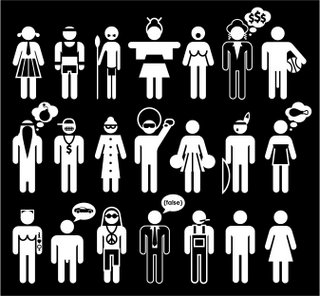Although we know that the use of stereotypes is not correct it is still a common phenomenon. Stereotyping is still widely used by individuals, organizations, media and politics. In some cases complete groups are systematically been put down.
The term stereotype is composed of two ancient Greek terms- Stereos, which is a Greek prefix that means rigid and solid, and typos, which means letter, type and character (Kubler, 1941). Stereotypes can also be defined as “pictures in our heads”. Stereotyping is an automatic assumption that people make. People assume that different (relatively) homogeneous groups significantly differ from other groups. It is not only about external features such as, origin, clothes or looks. People are also tending to add behavioral characteristics to it. By creating a stereotype group we assume that every person who joins this group immediately takes over certain behavior.
Stereotyping and prejudices can cause a lot of miscommunication. A common problem within organizations is that stereotyping is often unrecognized, invisible and unspoken, but could have a very big impact. This kind of stereotyping is often expressed in so called ‘Micro- inequities’. This term stands for sarcastic comments and non-social behaviors (often unconsciously) towards others who are in some way different. Within one second, we estimate a person, young, old, smart, stupid, attractive, not attractive, and interesting or not. For example, femininity is a valuable positive attribute in nursing or teaching occupations, but not in traditionally male-dominated occupations, such as engineering or sciences.
We think that we know how the other person works, but of course this is a big mistake. By judging others we limit our communication with these generalities. We cannot directly judge behavior without understanding where it comes from.
“Every judgment that you make, says as much about yourself as it says about the other person”.

Why we use stereotypes
As I said before stereotyping is an automatic assumption that people make. Also known as ‘biases’ in our brains. A cognitive bias is the human tendency to make systematic ‘thinking’ errors based on cognitive factors rather than evidence. Cognitive biases are a common outcome of human thought, and often drastically skew the reliability of legal evidence. This may sound difficult but it comes down to the following;
People use ‘heuristics’ to give direction to their thoughts. Heuristic refers to experience- based techniques for problem solving, learning, and discovering. We use heuristic methods to speed up different processes in our minds to find a good solution (identifying, interpreting and analyzing). It makes our daily lives much more easy because we do not have to investigate (and think about) everything over and over again. For example, once you decided that fruit and bread are healthy thinks to eat for breakfast, you will not wonder every single morning again if bread and fruit are really that healthy for you. Or why these products are good for you and what the ingredients are, right? If you do that, every day you’d be hours late for work.
We make our own routines and rules, these rules work well under most circumstances, such as the breakfast example, but in certain cases, this leads to systematic errors in our brains. In case of stereotyping this ‘heuristics’ could work against us.
“We put other people in boxes to make our own thoughts easier”
As said earlier we use heuristic methods to speed up different processes in our minds, minimizing the energy used in day to day life. If you want to communicate with another person you need to think outside of these boxes and stereotypes. You have to put yourself in the position of the other person. Because stereotypes and prejudices are based on misinformation, for a long period researchers thought that the problem could be fixed by right education. But it is proven that this is not true, also high educated people use and think in stereotypes (Lazarsfeld, 1940).
Stereotyping and prejudices will always be a part in our day to day life and will cause a lot of miscommunication.
With taking a bit of extra energy, we maybe can judge a book by its contents and not its cover.